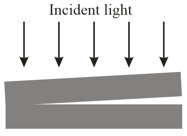Transmission through thin layers. In the figure given below light is incident perpendicularly on a thin layer of material that lies between (thicker) materials and (The rays are tilted only for clarity.) Part of the light ends up in material as ray (the light does not reflect inside material ) and (the light reflects twice inside material ). The waves of and interfere and here we consider the type of interference to be either maximum (max) or minimum (min). For this situation, each problem in the table refers to the indices of refraction and the type of interference, the thin-layer thickness in nanometers, and the wavelength in nanometers of the light as measured in air. Where is missing, give the wavelength that is in the visible range. Where is missing give the second least thickness or the third least thickness as indicated.
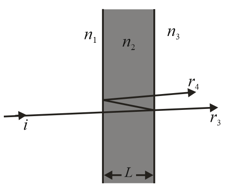


Important Questions on Interference
Figure a shows a lens with radius of curvature lying on a flat glass plate and illuminated from above by light with wavelength . Figure b (a photograph taken from above the lens) shows that circular interference fringes (known as Newton's rings) appear, associated will une variable thickness d of the air film between the lens and the plate. Find the radii of the interference maxima assuming
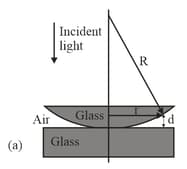
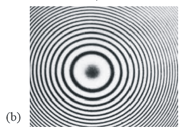
The lens in Newton's rings experiment (see figure) has diameter and For in air, how many bright rings are produced with the setup (a) in air and when immersed in water
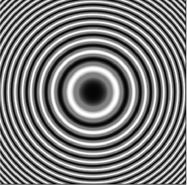
A Newton's ring apparatus is to be used to determine the radius of curvature of a lens (see figure). The radii of the and bright rings are found to be and respectively, in light of wavelength . Calculate the radius of curvature of the lower surface of the lens.
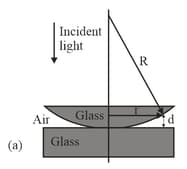
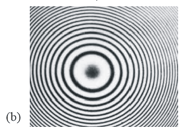
In Figure a broad beam of light of wavelength is sent directly downward through the top plate of a pair of glass plates touching at the left end. The air between the plates acts as a thin film, and an interference pattern can be seen from above the plates. Initially, a dark fringe lies at the left end, a bright fringe lies at the right end, a bright fringe lies at the right end and nine dark fringes lie between those two end fringes. The plates are then very gradually squeezed together at a constant rate to decrease the angle between them. As a result, the fringe at the right side changes between being bright to being dark every (a) At what rate is the spacing between the plates at the right end being changed? (b) By how much has the spacing there changed when both left and right ends have a dark fringe and there are five dark fringes between them?
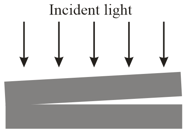
In the figure below two microscope slides touch at one end and are separated at the other end. When light of wavelength shines vertically down on the slides, an overhead observer sees an interference pattern on the slides with the dark fringes separated by What is the angle between the slides?
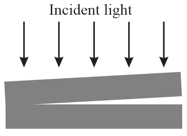
In the figure, a broad beam of monochromatic light is directed perpendicularly through two glass plates that are held together at one end to create a wedge of air between them. An observer intercepting the light reflected from the wedge of air, which acts as a thin film, sees dark fringes along the length of the wedge. When the air between the plates is evacuated, only dark fringes are seen. Calculate to six significant figures the index of refraction of air from these data.
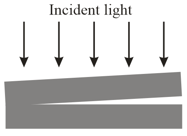
In the figure below, a broad beam of light of wavelength is sent directly downward through the top plate of a pair of glass plates. The plates are long, touch at the left end, and are separated by at the right end. The air between the plates acts as a thin film. How many bright fringes will be seen by an observer looking down through the top plate?
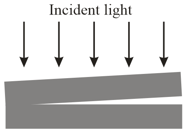
Two rectangular glass plates are in contact along one edge and are separated along the opposite edge (Figure). Light with a wavelength of is incident perpendicularly onto the top plate. The air between the plates acts as a thin film. Nine dark fringes and eight bright fringes are observed from above the top plate. If the distance between the two plates along the separated edges is increased by how many dark fringes will there then be across the top plate?
